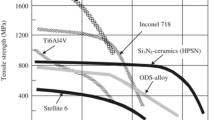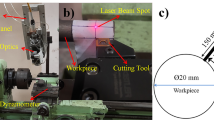Abstract
Waspaloy is a heat-resistant alloy primarily used in aircraft turbine engines, as forged turbine and compressor disk, which is difficult to machine at room temperature due to excessive tool wear and poor surface finish. Laser-assisted machining (LAM) offers the ability to machine such superalloys more efficiently by locally heating and softening the workpiece material prior to material removal and machining with a conventional single-point cutting tool. A transient, three-dimensional heat transfer model is used for modeling LAM of Waspaloy. The thermal model is validated by comparing the temperature predictions and the surface temperature measurements using an infrared camera. The machinability of Waspaloy under varying conditions is evaluated by examining tool wear, cutting forces, and surface finish. With increasing material removal temperature from room temperature to 300–400°C, the benefit of LAM is demonstrated by a 20% decrease in specific cutting energy, a two- to three-fold improvement in surface roughness, and a 50% increase in ceramic tool life over conventional machining.
Similar content being viewed by others
References
Klopp WD (ed) (1999) Aerospace structural metals handbook: Waspaloy. Purdue Research Foundation, West Lafayette, Indiana
Vander Voort GF (ed) (2004) ASM handbook: metallography and microstructures. ASM International,
Mannan S, Patel S, deBarbadillo J (2000) Long term thermal stability of INCONEL alloys 718, 706, 909, and WASPALOY at 593 C and 704 C. In: Superalloys 2000. Proceedings of the Ninth International Symposium on Superalloys, 17-21 Sept. 2000, Warrendale, PA, USA, 2000. SUPERALLOYS 2000. Proceedings of the Ninth International Symposium on Superalloys. TMS-Miner. Metals & Mater. Soc, pp 449-458
Konig W, Gerschwiler K (1999) Machining nickel-based superalloys. Manuf Eng 122:102–108
Noaker PM (1994) When face milling pays off. Manuf Eng 113:73–77
Roy AK, Venkatesh A, Marthandam V, Ghosh A (2008) Tensile deformation of a nickel-based alloy at elevated temperatures. J Mater Eng Perform 17:607–611
Khamsehzadeh H (1991) Behaviour of ceramic cutting tools when machining superalloys University of Warwick, United Kingdom
Shaw MC, Thurman AL, Ahlgren HJ (1965) Plasticity problem involving plane strain and plane stress simultaneously—groove formation in machining of high-temperature alloys. In: ASME Meeting PROD-10, New York, NY, United States, Jun 9-11 1965 1965. American Society of Mechanical Engineers—Papers. American Society of Mechanical Engineers (ASME), p 5
Moltrecht KEH. Turning of high temperature alloys. In: 32nd ASTME Annual Meeting, 1964, 1964. ASTME-Collected Papers. p 31
Lee M, Horne JG, Tabor D (1979) Mechanism of notch formation at the depth of cut line of ceramic tools machining nickel-based superalloys. Electric Power Research Institute (Report) EPRI EL:460-469.
Barrett R, Page TF (1990) The interactions of an Al2O3-SiC-whisker-reinforced composite ceramic with liquid metals. Wear 138(1–2):225–237
Narutaki N, Yamane Y, Hayashi K, Kitagawa T, Uehara K (1993) High-speed machining of Inconel 718 with ceramic tools. CIRP Ann Manuf Technol 42:103–106
Kitagawa T, Kubo A, Makawa K (1997) Temperature and wear of cutting tools in high-speed machining of Inconel 718 and Ti-6Al-6 V-2Sn. Wear 202:142–148
Rozzi JC, Pfefferkorn FE, Incropera FP, Shin YC (2000) Transient, three-dimensional heat transfer model for the laser assisted machining of silicon nitride: I. Comparison of predictions with measured surface temperature histories. Int J Heat Mass Transf 43(8):1409–1424
Tian Y, Shin YC (2006) Thermal modeling for laser-assisted machining of silicon nitride ceramics with complex features. Journal of Manufacturing Science and Engineering, Transactions of the ASME 128:425–434
Anderson M, Patwa R, Shin YC (2006) Laser-assisted machining of Inconel 718 with an economic analysis. Int J Mach Tool Manuf 46(14):1879–1891
Dandekar CR, Shin YC, Barnes J (2010) Machinability improvement of titanium alloy (Ti-6Al-4 V) via LAM and hybrid machining. Int J Mach Tool Manuf 50(2):174–182
Anderson MC, Shin YC (2006) Laser-assisted machining of an austenitic stainless steel: P550. Proceedings of the Institution of Mechanical Engineers, Part B: Journal of Engineering Manufacture 220:2055–2067
Ding H, Shin YC (2010) Laser-assisted machining of hardened steel parts with surface integrity analysis. Int J Mach Tool Manuf 50(1):106–114
Skvarenina S, Shin YC (2006) Laser-assisted machining of compacted graphite iron. Int J Mach Tool Manuf 46(1):7–17
Kumar AS, Durai AR, Sornakumar T (2006) Wear behaviour of alumina-based ceramic cutting tools on machining steels. Tribol Int 39(3):191–197
Richards N, Aspinwall D (1989) Use of ceramic tools for machining nickel based alloys. Int J Mach Tool Manuf 29(4):575–588
Lo Casto S, Lo Valvo E, Lucchini E, Maschio S, Piacentini M, Ruisi VF (1999) Ceramic materials wear mechanisms when cutting nickel-based alloys. Wear 225-229, Part 1 (0):227-233.
Zhang X, Wu S, Wang H, Liu CR (2011) Predicting the effects of cutting parameters and tool Geometry on hard turning process using finite element method. J Manuf Sci Eng 133(4):041010
Liu L, Hirose A, Kobayashi KF (2002) A numerical approach for predicting laser surface annealing process of Inconel 718. Acta Materialia 50(6):1331–1347
Dreshfield R (1993) Evaluation of mechanical properties of a low-cobalt wrought superalloy. J Mater Eng Perform 2(4):517–522
Ho HS, Risbet M, Feaugas X, Moulin G (2011) Damage mechanism related to localization of plastic deformation of Waspaloy(TM): effect of grain size. Procedia Engineering 10:863–868
Pusavec F, Hamdi H, Kopac J, Jawahir IS (2011) Surface integrity in cryogenic machining of nickel based alloy—Inconel 718. J Mater Process Technol 211(4):773–783
Attia H, Tavakoli S, Vargas R, Thomson V (2010) Laser-assisted high-speed finish turning of superalloy Inconel 718 under dry conditions. CIRP Ann Manuf Technol 59(1):83–88
Ding H, Shin YC (2012) Dislocation density-based modeling of subsurface grain refinement with laser-induced shock compression. Comput Mater Sci 53(1):79–88
Lee W-S, Lin C-F, Chen T-H, Chen H-W (2011) Dynamic mechanical behaviour and dislocation substructure evolution of Inconel 718 over wide temperature range. Mater Sci Eng, A 528(19–20):6279–6286
Ding H, Shen N, Shin YC (2011) Modeling of grain refinement in aluminum and copper subjected to cutting. Comput Mater Sci 50(10):3016–3025
Hirose A, Arita Y, Nakanishi Y, Kobayashi KF (1996) Decrease in hydrogen embrittlement sensitivity of INCONEL 718 by laser surface softening. Mater Sci Eng, A 219(1–2):71–79
Liu L, Zhai C, Lu C, Ding W, Hirose A, Kobayashi KF (2005) Study of the effect of [delta] phase on hydrogen embrittlement of Inconel 718 by notch tensile tests. Corros Sci 47(2):355–367
Author information
Authors and Affiliations
Corresponding author
Rights and permissions
About this article
Cite this article
Ding, H., Shin, Y.C. Improvement of machinability of Waspaloy via laser-assisted machining. Int J Adv Manuf Technol 64, 475–486 (2013). https://doi.org/10.1007/s00170-012-4012-8
Received:
Accepted:
Published:
Issue Date:
DOI: https://doi.org/10.1007/s00170-012-4012-8




